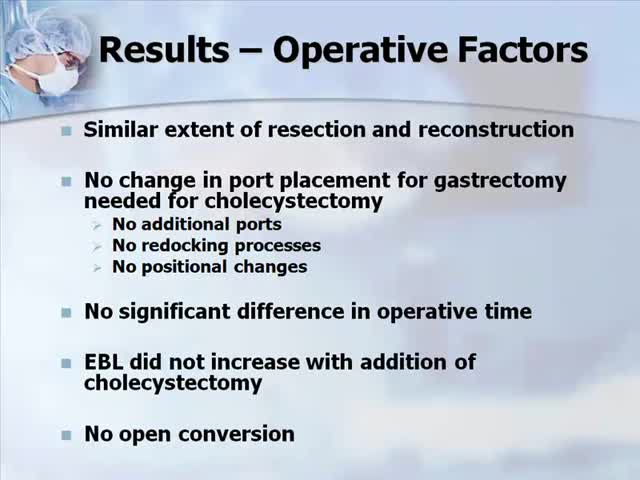
Chicago 2009 Video – Combined Robot-Assisted Operations Successfully Treat Coexisting Intraabdominal Disesases
January 20, 2010
Y. Woo
Background/Hypothesis
Advancements in minimally invasive surgical techniques have allowed for surgeons to safely combine various laparoscopic procedures including hernioraphies, cholecystectomies, nephrectomies, prostatectomies, and hysterectomies. Few reports exist, however, on the feasibility and safety of combined robotic procedures. We present our institutions successful robotic approach to simultaneous treatment of early gastric cancer and coexisting biliary pathology.
Materials & Methods
Seven of the two-hundred forty-seven patients undergoing surgery for gastric cancers with the da Vinci Robot at Yonsei University Health System, Seoul, Korea between July 2005 and April 2009, received simultaneous cholecystectomies for benign biliary disease. The data from these patients were prospectively collected and retrospectively analyzed for total operative time, docking time, laparoscopic-assist time, postoperative length of hospital stay, morbidity and mortality.
Results
Two of seven (28%) total gastrectomies with Roux-en-Y esophagojejunostomy and 5 of 7 (72%) subtotal distal gastrectomies with BII were combined successfully with robotic cholecystectomy without conversion to open procedure. All the procedures were performed by usual port placement for gastric cancer without additional port, redocking process or positional changes. Total operative time was 233+45.8.0 min for combined procedures ranging from170 min to 300 min. Robot docking time (4.57min +0.07min), robot operative times (of 136.7min +34.5min), and laparoscopic assist time (65min +17.9min) were consistent with non-combined procedures. Postoperative hospital length of stay was 5-11 days
(average 7 days) and no postoperative complications occurred in these patients. No statistically significant differences were found in the intraoperative and postoperative factors between robotic gastrectomy alone and combined robotic gastrectomy and cholecystectomy.
Conclusions
Our institutional experience suggests that cholecystectomies can safely be combined with robotic total and distal subtotal gastrectomies during the surgical treatment of gastric cancer. The safety, feasibility, and advantages of combining more complicated robotic procedures still need to be evaluated and requires careful future analysis.







